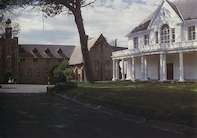First Diocesan Bishop of Cape Colony
Bishops: the name is known, admired and respected not only in South Africa but abroad, in international cloisters wherever great schools are discussed.

A Bishops Old Boy - an Old Diocesan, or OD - is part of a unique family forged out of the vision of a remarkable pioneering Anglican churchman almost 150 years ago, when six young sons of Cape professional men sat down in a makeshift cottage schoolroom under the leafy oaks below Table Mountain and began taking instruction from a cassocked clerical tutor.
Jan van Riebeeck once owned the land on which Bishops was founded. Van Riebeeck's extended farm near the Liesbeek River was called Boschheuvel; the land passed from owner to owner over time, it became known as Protea - dubbed so in 1835 by the then owner, Honoratius Maynier, who was captivated by the abundance of these wild flowers that adorned his mountainside retreat.
Almost two hundred years after the Dutch ship's surgeon had founded his refreshment station at this southern point of Africa, an alert, distinguished-looking Anglican clergyman, Robert Gray, landed on the same shores to take up his duties as first diocesan Bishop of the Colony. On his arrival in 1848 Bishop Gray rented Protea from the owner, Honoratius Maynier's grandson, as his first official home.
Bishop Gray arrived in Cape Town with a Bible in one hand and a slate in the other, determined that he was going to enhance both the spiritual and educational life of the residents. Appalled by the haphazard approach to education and the poor standards that existed in the local secular schools, Bishop Gray decided that the Church of England would lead the way in establishing responsible and comprehensive education to a higher degree in the Cape.
First Pupils of Bishops
When Bishop Gray began looking around for a place to start a 'collegiate school' - his term for a system embracing a lower elementary school leading to an upper department, similar to an English university - he almost bought the South African College (now SACS), which was in financial trouble and on the market. But he decided the risk was not worth it and instead opened his own institution, on 15 March 1849, in Maynier's Cottage on the grounds of his residence.
From the beginning, the administration of his school, its curriculum and staffing, was inspired by his connections with Radley College in England, and it was no coincidence that the first new buildings to be erected on the Rondebosch site that finally became forever the home of Bishops were similar in design to Radley's.
The first term of the Bishop's school opened with six pupils (about all it could accommodate to begin with). Each boy was asked to bring with him his baptismal certificate, six towels, two pairs of sheets, two silver forks and spoons, and any school books he had, as the fledgling school was still awaiting a proper supply from England. The boys were all boarders, aged between 10 and 15.